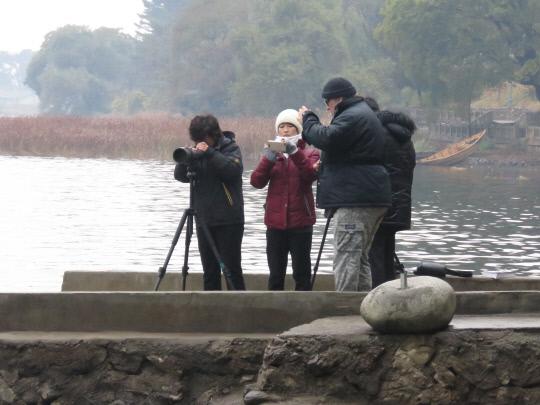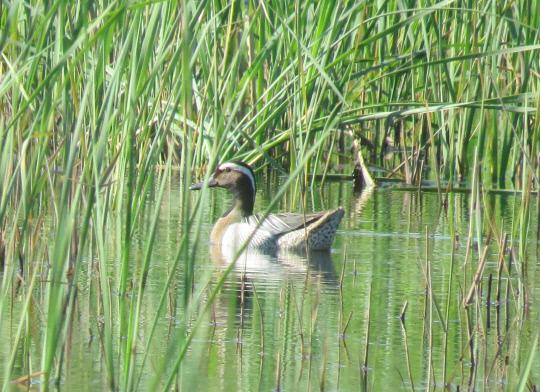
북한의 농업은 아직도 기계나 인공 비료의 사용이 적다. 협동농장에서 농약이나 제초제는 찾아보기 어렵다. 그래서 상대적으로 한국에 비해 곤충을 포함한 생태계 다양성이 잘 유지되고 있다. 한국에서 흔히 볼 수 있는 비닐하우스나 인삼재배 밭은 북한에 없다. 한때 한국에서 흔했던 노랑때까치는 지금은 DMZ 지역을 제외하고는 더 이상 번식하지 않는 것으로 추정되지만 북한에서는 아직 많은 수의 노랑때까치가 서식하고 있다. 벼농사를 짓는 곳이면 어디서든 흔하게 볼 수 있었던 뜸부기도 북한에서는 왕성하게 번식활동을 하고 있다. 조간대습지의 약 75%와 대부분의 내륙습지가 사라진 한국과 달리 다행히 북한의 연안습지 상황은 나쁘지 않은 것으로 보인다.
하지만 북한의 자연환경에 아무런 문제가 없는 것은 아니다. 1990년대 초반 대기근과 경제위기의 결과로 대규모 산림황폐화가 진행됐다. 기본 생활을 영위하기 위해 주민들이 인근 산림의 나무를 베었으며 경사지 농업을 시작했기 때문이다. 그로 인한 홍수피해가 또다른 경제적 위기로 이어지고 인명피해가 발생하기 시작했다. 이는 동식물에게도 커다란 피해로 작용했다. 함흥이나 평성과 같은 지역은 산업단지와 화학공장으로 인한 대기오염 및 수질오염이 극심한 상황이다.
1920년대 이후 북한의 습지에 관한 연구는 거의 진행되지 않았으나 1990년대 중반 대기근으로 인해 북한이 부분적으로 국가를 개방하기 시작하면서 소수의 연구자들이 현장에 접근할 수 있는 기회를 얻었다. 도쿄 소재 조선대학교의 정종렬 교수는 북한의 습지목록을 처음으로 출판하면서 북한 습지와 관련한 주요 연구에 한 획을 그었고 이후 저어새와 같은 조류종을 중심으로 다양한 연구를 심층적으로 진행하하기도 했다. 이후 2014년이 되어서야 한스자이델 재단 한국 사무소가 북한 라선 인근 두만강 하류 지역에서 습지에 관한 현장조사 및 연구를 시작할 수 있었다. 2015년부터는 북한 국토환경보호성과 WWF, IUCN, EAAFP와 같은 국제적 파트너들과 협력하는 프로그램을 진행하게 됐으며, 이를 기반으로 철새이동경로를 보호하기 위해 EAAFP나 람사르 협약 등에 북한이 정식으로 가입하는 것이 프로그램의 최종 목표였다.
습지는 인간 생존에 있어 매우 중요한 역할을 담당하고 있다. 뿐만 아니라 수많은 동식물이 번식하고 서식해 생물다양성을 유지할 수 있도록 해준다. 특히 인간에게는 담수, 식재료, 건축자재 등을 공급하고 생태다양성, 홍수 조절, 지하수, 기후변화 경감 등 수많은 자연환경의 문제에 직간적접적으로 영향을 미친다. 지난 4년간 북한 국토환경보호성과 한스자이델재단은 수많은 파트너들과 함께 북한 습지와 관련해 다양한 프로젝트를 진행해왔다. 이를 통해 습지 및 철새의 중요성에 관한 인식을 제고하고 습지 관리자 및 환경 분야 종사자들의 역량을 강화하며 동남아시아 지역을 비롯한 전세계적인 환경 네트워크에 북한이 포함될 수 있도록 노력해왔다. 이를 위해 북한 라선 시에서 여섯 차례, 북한의 동해안에서 두 차례 등 수차례 습지 현장조사를 실시했다. 2018년 북한은 마침내 EAAFP와 람사르 협약의 가입국이 됐으며 73곳의 주요 습지를 포함한 새로운 습지목록을 출판했다. 서해안의 문덕과 동해안의 라선은 람사르 습지로 지정되기도 했다.
하지만 북한의 이야기는 이처럼 아름답게 끝나지는 않는다. 기계가 부족한 북한에서도 간척사업이 진행되고 있다. 현금을 벌 수 있는 사업에 몰두하고 있는 북한에게 양식업과 같은 사업의 기회는 람사르 지역과 다른 습지에 위협요소로 작용하고 있다. 뿐만 아니라 귀중한 서식지를 보존하는 일은 주민들이 생계를 유지하는 일과 균형을 맞추어 진행되어야 한다. 만일 환경을 파괴해야만 사람들이 살 수 있다면 이는 비극일 것이다. 그러므로 환경보호는 수많은 경제 제재의 국면 속에서도 한국이 북한에게 큰 도움을 줄 수 있는, 그리고 주어야 하는 분야이다.
베른하르트 젤리거(Bernhard Seliger) 박사(한스자이델재단 한국사무소 대표)
*번역은 한스자이델 재단에서 진행했으며 일부 한글 번역 문장은 맥락이 훼손되지 않은 범위내에서 편집했음. 다음은 영문 원본.
Wetlands of North Korea
Dr. Bernhard Seliger(Hanns-Seidel-Foundation Korea)
When we think of North Korea, immediately the nuclear issue, the ideology, and poverty come to mind. But what does that mean for the environment? Is it a paradise yet to be discovered, or did human tragedy also mean a tragedy for the environment? Actually, this is a very interesting and complex question: On the one hand, North Korea still largely follows a style of agriculture with few machines and artificial inputs – usually, ploughing is done by oxen (or very old tractors), rice plantation by masses of people with their hands, and harvest equally. Pesticides and herbicides are often scarce in the collective farms. Insect life is therefore much more diverse still than in the Southern part of the Peninsula, where agriculture is very intensive. The ubiquitous hot-houses and ginseng plantations of the South do not exist. Species like the brown shrike, once a frequent summer visitor in South Korea, but now probably not breeding any more, with the exception of the DMZ area, can be found in many places and often in quite astonishing numbers in the North. Also, the water cock, once everywhere at home in the country, where rice plantations are to be found, still thrives in the North, though hunting in the wintering grounds in Southeast Asia also took a toll at its numbers. On the other hand, however, the environment of North Korea is not without challenges. Since the early 1990s, massive deforestation was the consequence of the famine and economic break-down – people needed fire wood for heating and cooking, and they started to farm slope-lands, often leading to barren and devastated bush lands, where formerly forests were. Frequent floods were an economic disaster and took a toll of human life, but also negatively affected fauna and flora. And, near industrial areas and chemical plants like in Hamheung or Pyongseong the situation of pollution of water and air is very dire.
However, particular with regard to coastal wetlands, the situation in North Korea is still much better than in South Korea, where rapid development led to a loss of 75 percent of all tidal flat areas and much of the inland wetlands, too. While since the 1920s for a long time almost no research was done on wetlands of North Korea, this changed with the partial opening brought by the famine in the mid-1990s, when a few researchers could access the country. Of particular importance is the work of Prof. Chong Jong-Ryol of the North Korean University in Tokyo, who for the first time published a wetland inventory for North Korea, and did a lot of important work on species like the Black-Faced Spoonbill. Also, with the help of UNDP and UNEP, projects for the biodiversity-rich West coast area were developed. However, the nuclear development of North Korea halted that again. Only from 2014, Hanns-Seidel-Foundation Korea began research on wetlands in the Tumen estuary in Rason. From 2015, a program with the Ministry of Land and Environment Planning (MoLEP) of North Korea started, with international partners like WWF, IUCN and the East Asian Australasian Flyway Partnership (EAAPF). It was a goal of the project to prepare North Korea for membership in the EAAFP, an organization of states and NGO to preserve migratory birds in the Asia-Pacific, but also the Ramsar Convention on Wetlands, a large inter-governmental body to protect wetlands. Wetlands are vital for human survival. They are among the world’s most productive environments; cradles of biological diversity that provide the water and productivity upon which countless species of plants and animals depend for survival. But also for humans they are indispensable, providing services ranging from freshwater supply, food and building materials, and biodiversity, to flood control, groundwater recharge, and climate change mitigation. In the past four years, MoLEP and Hanns-Seidel-Foundation with other partners carried out an intensive program to raise awareness of wetlands and their fauna and flora, in particular migratory birds, build capacity for managers of wetlands and environmental administrators, and integrate North Korea into networks of wetland protection in Northeast Asia and beyond. A number of wetland surveys were carried out by MoLEP and HSF, among them six in Rason and two along the East Coast of North Korea. Other organizations, like Miranda Purokoko Trust of New Zealand, did research at the Korean West coast. In 2018, North Korea finally became member of EAAFP and the Ramsar Convention, published a new Wetland inventory detailing the 73 most important wetlands in the country and designating two areas, Mundok at the West Coast and Rason at the East Coast, as Ramsar sites.
This could be the happy end to the story, but this is not the case: also in the North Korea tidal flat reclamation goes on, though due to a lack of heavy machinery at a slower pace. New businesses in cash-strapped North Korea, like a new aquaculture farm in Rason, threaten the Ramsar sites and other wetlands. And the hope of humans for better living conditions everywhere in the country have to be balanced with the need to preserve valuable habitats. It would be a tragedy, if the hopes of people could only be realized by destroying the environment. Therefore, environmental protection, and in particular nature protection, are a prime area, where South Korea could – even in the time of economic sanctions – offer large-scale aid to the North, as a way to preserve resources belonging to the whole Korean people and Korean Peninsula.
<저작권자ⓒ대전일보사. 무단전재-재배포 금지>





